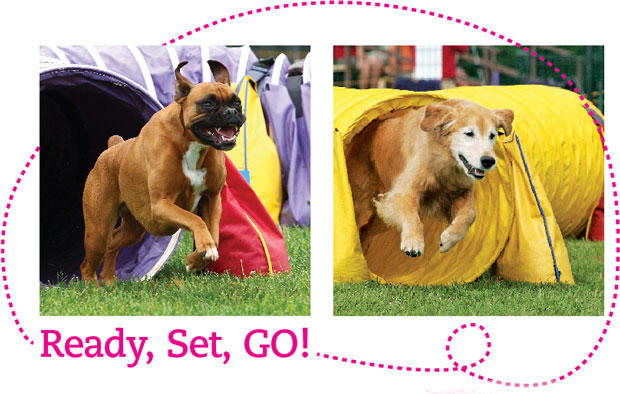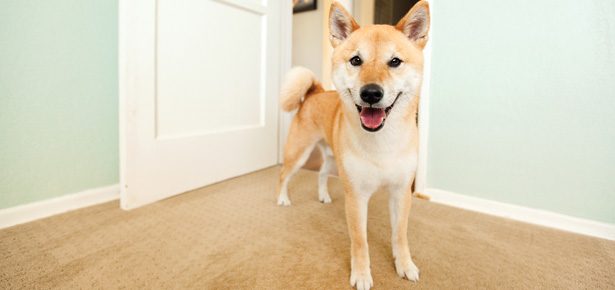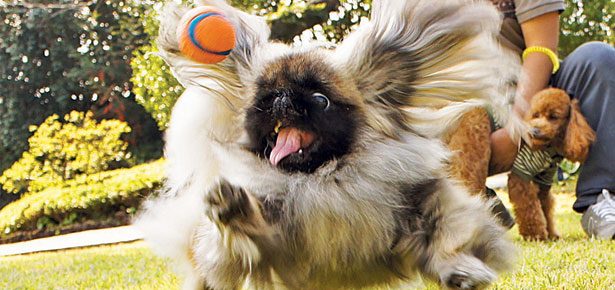
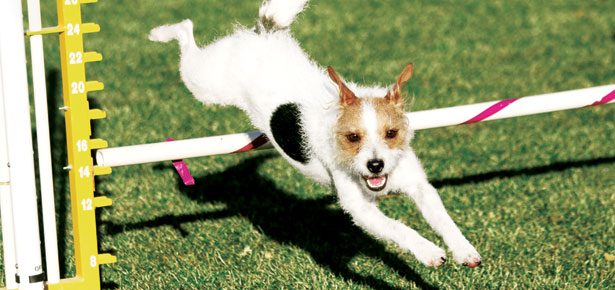
Is Agility Right for Your Dog?
Thinking about trying out agility? Here’s what you need to know to get started
“Yes, Jasper likes to jump off things—that’s actually an understatement,” laughs Vancouver, BC’s Leanna Fillo, as she recounts how she and her Sheltie-Shepherd cross first got involved in dog agility, a sport in which a human handler directs a dog through an obstacle course in a race for both time and accuracy.
“We just finished our basic obedience class at DogSmart Training, and I could really see how focused he was on me and how bonded we had become,” she says. “I wanted to keep the momentum going, so I started looking for our next challenge—something that would stimulate both Jasper and myself mentally and physically and give us more time to be together, to work together and to bond.”
Fillo had heard about agility training before, and decided to look into beginner classes. Once she discovered more about what would be involved, she says she “knew that Jasper would be a shoo-in for the sport.”
A natural he is, thanks in part to his unique mixture of breeds. According to the United States Dog Agility Association, Shetland Sheepdogs, Australian Shepherds, and Border Collies all rank among the top dogs to run agility and win trials. But if you’re thinking of trying agility with your mutt, don’t be dissuaded by his or her bloodline.
“Certain types of dogs—working and herding dogs come to mind—are often considered as ‘naturals’ for agility but, the truth is, any breed can do it,” says Becky Woodruff, a North American Dog Agility Council (NADAC) seminar clinician based in Bend, Oregon.
“I’ve seen Jack Russell Terriers, Standard Poodles, Pomeranians—pretty much every type of dog, purebred and mixed breed, excel at this sport. Of course, a big St. Bernard may not be as agile as a Sheltie, and a Basset Hound, low to the ground, likely can’t catch a Border Collie, but they can still be very successful at agility. It’s an all-inclusive activity for people and their pets.”
In fact, the sport of agility—which was started in England in the late 1970s and was then introduced to North America in the early ’80s—is structured so that nearly all handlers and dogs can participate at some level. This includes dogs of all shapes, sizes and ages—and their humans, as well.
“NADAC, for instance, has a junior division for kids, which is really fun and exciting to watch,” says Woodruff. “Also, in competition, the animals are measured for height at the shoulder and placed in a category that includes equipment to match. Our aim is to structure it so everyone with a healthy dog can at least give agility a try and reap the benefits.”
And the benefits of agility, agrees Mark Shambour, owner of K9 Korral Obedience Training Centre in Sarasota, Florida, are many.
“The dogs just love it; most of them have what can only be described as huge grins on their faces the whole time they’re moving through a course,” he says. “Agility presents them with a challenge—how quickly and how well they can do the equipment—and the whole time they’re looking to you for instruction. From a pup’s perspective, what could be better?”
While agility classes at Shambour’s facility are “strictly for fun,” he says competition is something individual handlers can decide to do once they’ve got a feel for the sport and a sense of how successful their dog has been.
“For beginners, I’d recommend keeping it light when you’re first starting out, seeing how your dog takes to it and how well you enjoy it,” he says. “Most importantly, leave any attitude at the door and be aware of how your dog is feeling.”
While most pups either “take to agility like ducks to water” or, with some time, become accustomed to the sport, Shambour says it’s important to watch for signs that your dog is not enjoying the activity.
“It’s very rare, but there are some dogs too frightened or anxious to get on the equipment or who simply don’t like the stimulation of being with many other dogs in a social, group setting,” he explains. “In those cases, it might just take some extra time or treats or some private agility classes to get them tuned in. What I tell my clients is, don’t force the dog to do it, let it happen on its own terms.”
If your dog is elderly or suffers from health problems that could limit her range of motion, that may be a reason not to pursue agility—but even in those cases, gentler courses can be set up for senior or disabled dogs to run. As for handlers who are getting up in years, Shambour says that his indoor agility course in Florida is a godsend.
“We’ve got a fully air conditioned facility and, in the heat of summer, we’re cool as cucumbers in here,” he says. “It’s a wonderful way to get out of the heat—and away from the mosquitos—without sacrificing Fido’s exercise.”
In Harrowsmith, Ontario, just northeast of Toronto, Jennifer Laird has been running dogs for about seven years now. In contrast to beating the Florida heat, she calls dog agility a “great way to exercise your pet throughout the cold winter months.”
Laird, who is secretary of the Agility Association of Canada—a national body that governs the sport as it grows and ensures the well-being and safety of all involved—started out in agility with an unlikely dog: a nine-year-old rescue Dalmatian named Frederica.
“She had no skills whatsoever when she came to me; she was this totally hyper dog that simply refused to listen,” she recalls. “Part of the problem was the breed itself—Dalmatians were bred to be carriage dogs, whose job was to run in front of firefighting carriages to help clear a path and quickly guide the horses and firefighters to the fires. So, by instinct, these dogs don’t look to their people for direction.”
To solve the problem, Laird enrolled in basic obedience classes—every dog, she says, should know the basic commands sit, stay, and come, before attempting agility. Once Frederica had mastered that, it was time to move on to agility.
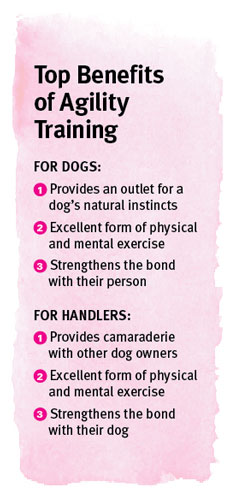
It worked, and Frederica thrived in agility; according to Laird, the Dalmatian “loved to go to class,” and would even start to perk up when she recognized the turn in the road that led to the training facility.
“She loved being with me, loved socializing with the other dogs there,” says Laird. “To be honest, the camaraderie with the other handlers was a big draw for me, too. No matter where you go, from coast to coast and on either side of the border, the [agility] community is just so wonderful—friendly, warm, welcoming, and wholly supportive. Everyone just wants to see everyone else succeed and, most importantly, enjoy themselves.”
Nearby, in Kemptville, Ontario, Linda DeVerno, president of one of Canada’s oldest agility clubs, Dogs 4 Fun, echoes Laird’s sentiments.
“No matter where you are, it’s always such a great group of people—and dogs!” DeVerno says. “In fact, agility is growing so much, I recommend that people who are thinking of trying it look for events in their area—there are so many different venues that host agility these days—and go and check it out. Talk to the people you meet there, ask questions … I promise, we won’t bite!”
>> For how to make your own backyard agility course, go to: moderndogmagazine.com/diyagility
Join the newsletter and never miss out on dog content again!
"*" indicates required fields
By clicking the arrow, you agree to our web Terms of Use and Privacy & Cookie Policy. Easy unsubscribe links are provided in every email.
